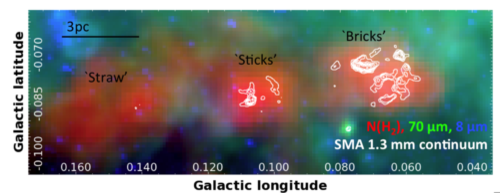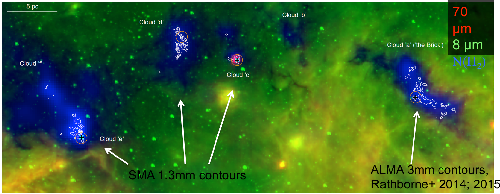Images

While extremely similar in their global properties, observations with the SMA reveal remarkably different substructure in the Three Little Pigs. From the widespread non-detections in the `straw' cloud, to moderate substructure in the `sticks' cloud and a complicated network of flaments and cores in the `Bricks' cloud, the origin of this variety is yet unknown. However, it allows us the unique opportunity to test models of tidal compression with different `initial conditions.' The Three Little Pigs are shown here in a three-color image (Red: Herschel PACS/SPIRE cold dust column density, Green: 70 μm, Blue: GLIMPSE 8 μm) while contours from the SMA Legacy Survey of the CMZ are shown in white, the lowest contour at 5 σ.

Three-colour image of the `dust-ridge' at the Galactic center. Green shows 8 μm data from the GLIMPSE survey, where these dense clouds stand out as absorption features. Blue shows the column density map from the HiGAL survey (Molinari et al. 2010; Battersby et al. 2011), in which the morphology of dust correlates well with the 8 μm extinction. Red shows Herschel 70 μm emission. There is a prominent 70 μm source seen towards the bottom of cloud `c'. White contours in cloud `a' show the 3mm emission seen with ALMA, and those in clouds `c', `d' and `e' show the 1.3mm emission seen with the SMA Legacy Survey of the CMZ. The most massive core in cloud `d' is completely quiescent { devoid of any star-formation tracers. That in cloud `a' is seen to coincide with weak water maser emission (black cross), indicating the early stages of star formation. The most massive core in cloud `e' contains both water and methanol maser emission (black and cyan crosses, respectively), and coincides with a weak 70 μm source (red), all suggestive of high-mass star formation. The core in cloud `c' contains both water and methanol maser emission (black and cyan crosses, respectively), and coincides with a strong 70 μm (red) source, which is indicative of more advanced high-mass star-formation.



